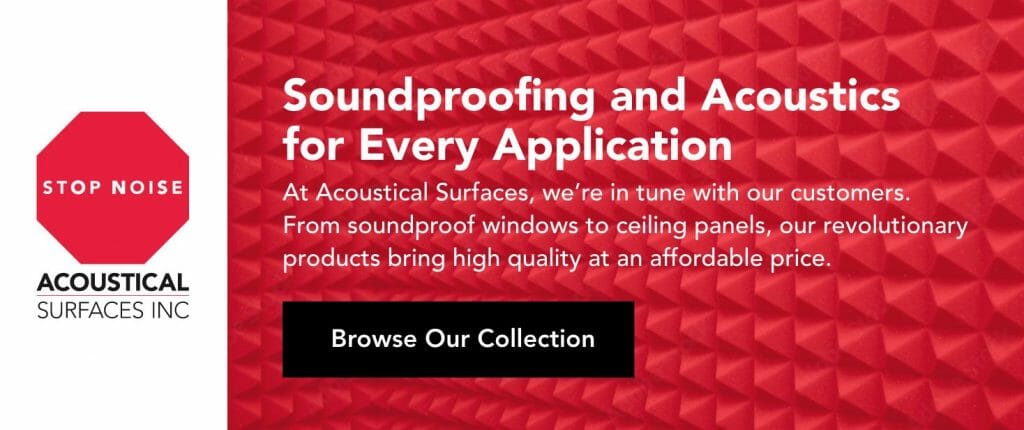Sound Diffusion & Absorption Explained
To bring out the best in your vocals and instruments, you need more than just warm-ups, lessons, and practice. You need a strong acoustic sound space. And when it comes to sound diffusion vs absorption, you need both for high-quality audio, each serving a unique purpose in crafting your ideal sound environment.
Absorption and diffusion are forms of room treatment centered on better sound quality. Sound diffusion spreads out sound energy with the use of acoustic diffuser panels. Sound absorption, on the other hand, makes use of porous material to soak up some of that energy.1
These methods differ from soundproofing, which is used to reduce unwanted noises in a room.
The Basics of Sound in Spaces
So why do you need room treatment in the first place? In short: most rooms not already built with acoustics in mind won’t create ideal soundscapes. In particular, hard, flat surfaces cause problems due to the science of sound.
Unwanted Reverberation
A reverberation happens when sound bounces from a surface and reflects back to the ear. Because these reflections travel further than the original sound, you end up with an echoing or reverberating effect. The biggest culprits of reverberative noise are:
- Hardwood or non-carpeted floors
- Flat walls
- High, flat ceilings
The more flat surfaces in a room, the more audio delays occur. This creates bigger, more noticeable flutter echoes and sound distortion.
Common Misconceptions
Popular misconceptions surround the use of sound absorption and diffusion tools in a room, warding some people away.
- Sound absorption and soundproofing are the same – As mentioned, sound absorption focuses on dampening sound energy in a room and may even deaden certain sounds, while professional soundproofing removes unwanted noise. They serve two different purposes.
- You only need sound absorption – Sound absorption on its own can create an uncanny, unrealistic soundscape that’s grating to a listener’s ear.
- Sound diffusion doesn’t do anything – In reality, it’s necessary to create rounded, full-bodied sounds especially in performance spaces.
These two tools alone can make a world of difference in the sound quality you produce. Let’s dive a little deeper into each one.
What Is Sound Absorption?
Sound absorption focuses on the reduction of sound energy, causing a shift in tonal perception. Not all frequencies get absorbed at the same rate, with higher frequencies muffling faster.
With this form of acoustic treatment, panels made of fibrous materials are placed on hard, flat, sound-reflecting surfaces like walls or floors. This reduces the sound energy bounced back.
Common materials for absorptive panels include:
- Fiberglass
- Cotton
- Mineral wool
- Wood wool
Having too many absorbers in a room may cause a perceptual disconnect between the expectation of a room’s sound and an overdamped acoustic reality.
What Is Sound Diffusion?
Compared to sound absorption, sound diffusion focuses on reflecting sound energy. This spreads it through a room in a more audibly pleasing way.2
Diffusers are most often used on the back wall of listening and control rooms. When used on the side and front walls, they can cause uneven frequency distribution.
In large performance spaces like a concert hall, methods of diffusion are often built into the physical geometry of the room. But it’s possible to create sound diffusion even in rooms that aren’t built for acoustic purposes through the use of geometric shapes.
The best sound diffuser geometries are:
- Cylinders – When broken into sections and placed around a room, they help spread sound energy evenly. This shape affects a wide frequency range and preserves timing signatures. Cylinders can diffuse on width or height, depending on orientation.
- Spheres – Similar to cylinders, they have a constant radius that ensures sound is spread consistently regardless of the angle soundwaves hit it from. These shapes diffuse in height and width.
When placed on walls and ceilings at the first reflection point in a listening space and recording studio, phase-coherent cylindrical sections improve the sound—and décor—in nearly any room or space imaginable.
Hit The Right Note with Acoustical Surfaces
Ultimately, a balance of absorption and diffusion is best for critical-listening rooms. Sound absorption gets rid of pesty frequencies you don’t want, while diffusion keeps a room sounding natural. Well-trained listeners tend to aim for a 50% mix of absorption and diffusion.
When you understand room treatment options, you open a path to one of the fastest ways of boosting the overall quality of your sound recordings and audio productions. While methods of treating your room may seem complicated at first, you start by focusing on just two elements—diffusion and absorption.
Acoustical Surfaces is here to support you as you head toward mastering your own unique sound. If you’re looking for top-of-the-line products to absorb any excess sound wave and reduce those crunchy audio artifacts, we have your back. If you want diffuser panels and tools to spread your sound out and knock down those harsh peaks in your microphone, we’ve got those, too.
Don’t set out on your sound journey alone. With the right tools and guidance, you can crank up the quality of your soundscape and give it that little extra something it’s been missing all this time.
Sources:
- Britannica. Sound absorption. https://www.britannica.com/science/sound-physics/Sound-absorption
- Sage Journals. The sound diffusion in Italian Opera Houses: Some examples. https://journals.sagepub.com/doi/abs/10.1177/1351010X20929216






